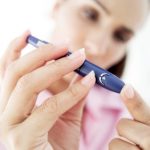Diabetes is in the top 10 causes of death in North America. About 24 million people in the U.S. have diabetes. One fourth of them don’t even know they have it. Diabetes is shown to be more common in African Americans, Latinos, Native Americans, and Asian Americans/Pacific Islanders, as well as the aged population.
Suspecting that you or a loved one might have diabetes can be scary! It is condition that causes sweeping changes to a person’s lifestyle. In most cases, because the early signs of diabetes are not known, being diagnosed comes as a shock.
However, there are affordable tests that can be done at home that can help diagnose diabetes at early stages. Also, being aware of the symptoms allows you to know whether home testing is needed. There are two major types of diabetes, type 1 and type 2. Type 1 diabetics produce little to no insulin; while type 2 diabetics are resistant to insulin.
Because it can be a difficult disease to pin point, it is very important to be aware of most common symptoms of diabetes. The symptoms for type 1 and type 2 diabetes are similar. Increased thirst is the most notable first symptom of high blood sugar. This is followed by frequent urination. The increased thirst, with the resulting frequent urination, is caused by the buildup of glucose in the blood stream that steals fluids from tissues. Other major symptoms are
- Sudden weight loss
- Fatigue
- Nausea
- Blurred vision
- Rapid and heavy breathing
If you or any loved one experiences any of these symptoms, it is time to do some simple tests to ascertain if these symptoms are signs of diabetes. Taking these tests will then determine the stage of diabetes; whether it is pre-diabetes or diabetes.
Test 1 – Urine Strips
A less invasive method for testing blood sugar is through urine glucose test strips. These strips should only be used to determine if high blood sugar is present. The strips do not read a blood sugar lower than 180 mg/dl and they are very easy to misinterpret. If glucose shows up on the urine test strips, it is important to test your blood sugar level using a blood sugar meter for a more accurate reading.
Test 2 – Blood Sugar Test
The easiest and most accurate at home test for diabetes is a blood sugar test. Blood sugar meters usually come with a small amount of test strips, as well as a lancing device. It is important to follow the directions included with the meter. Also, before testing your blood sugar, it is important to wash your hands first to eliminate any sugar residue, which could alter the readings. Normal fasting blood sugar should be between 70-130 mg/dl. If testing within two hours of eating, then the results should be less than 180 mg/dl.
Test 3 – At Home A1C Kits
Another method for testing for diabetes at home is the At Home A1C kit. These kits test the hemoglobin A1C and give a three-month average of your blood sugar. A normal A1C should be under 5.7%. When purchasing an at home A1C kits, make sure that it offers results within five minutes. Some of the at-home kits require sending a blood sample to a lab and waiting for three to six weeks for the results.
If any of the tests above show presence of glucose or high sugar level that falls under the diabetic range, it is time to consult a doctor. But if your test results show you are negative for diabetes or if you have pre-diabetes, you can take steps to reduce your risk of the disease:
- Lose weight. Research shows that reducing your body weight by 5 percent to 10 percent – 10 to 20 pounds for someone who weighs 200 pounds – can cut your diabetes risk of type 2 diabetes in half.
- Eat right. Your diet should be rich in vegetables, fruits, whole grains, low-fat dairy and lean protein sources. Limit foods high in saturated and trans-fats, cholesterol, sodium and added sugars.
- Exercise regularly. Work up to at least 30 minutes of exercise most days of the week. Always check with your doctor before you increase your activity
Advertisement

